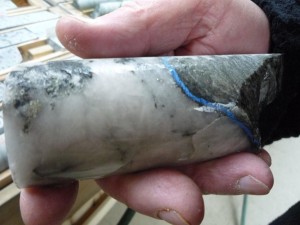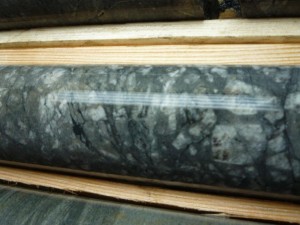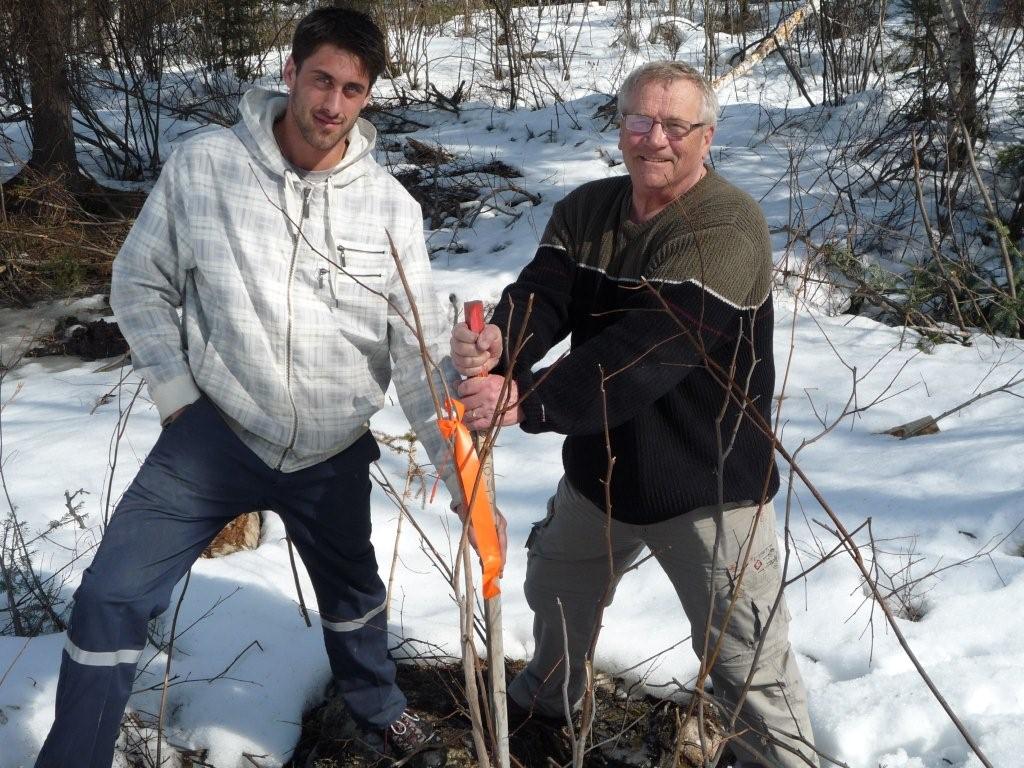From Rouyn-Noranda, Quebec – 11:30 pm EST 03/17/10
After three days at Gold Bullion Development’s (GBB, TSX-V) Granada Gold Property there’s no question we have a much better understanding of the scale and potential of this project. It’s one thing to sit in the comfort of an office and review technical reports, drill maps and assay results, and look at some nice pictures, but it’s quite another to actually strap on the boots, walk the property and get dirty and wet. It was our goal this week to get intimate with this property and that’s exactly what we did.
We encountered some knee-deep snow, some mud and a few obstacles to get to certain site areas and drill hole locations. We climbed some rocks and picked some up. We walked a lot and asked many questions. We spoke to geologists and metallurgists, and in general we got a great feel for the land and the possibilities and challenges ahead for Gold Bullion as it attempts to define a major bulk tonnage, open-pit gold deposit just six kilometres south of Rouyn.
We can now speak with a greater degree of authority on this project and we will state this emphatically: Gold Bullion has an incredible opportunity to turn the Granada Gold Property into a multi-million ounce deposit – near surface, bulk tonnage, open-pit. If you’re looking for serious “blue sky” potential in a mining exploration project, you have it right here with Granada. Bring out the drill rigs, drill and keep on drilling, Mr. Basa. Hundreds of holes and tens of thousands of metres. We believe that’s exactly what he’s going to do and we also believe he will succeed.
Areas to the north (the “Cadillac Trend” runs right through Gold Bullion’s northern claims) and the east hold the most potential at Granada – this covers a very large footprint – and will be priority targets once the next round of drilling starts, likely around the end of April/early May.
There’s evidence of mineralization almost everywhere at Granada, from the 400,000 tonne waste pile to the old mine workings to the rocks alongside the trails that lead out to the northeast discovery area. The LONG Bars Zone is generally quite flat or gentle sloping with limited overburden and an elevation of about 300 metres.
Below, we have a picture of Granada Mine Manager Karol Mikulash with Nathan Jourdain of GENIVAR, Gold Bullion’s geological consultant. They are standing at infamous Hole #17 , the easternmost hole drilled to date by Gold Bullion in the LONG Bars Zone (Karol on the right is a renowned metallurgist who’s worked on 10 mines in three different countries. He did Gold Bullion’s bulk sample and is tremendously excited about Granada’s prospects).
GR-10-17 intersected 65.5 metres of 1.21 grams per tonne gold (from 3.5 metres to 69 metres) within a wider interval of 0.953 gram per tonne gold over 99.2 metres, including 31.5 metres of 2.39 grams per tonne gold, and remains open at depth.
Prior to heading out to #17 today, we spent nearly two hours with Nathan and Karol at the core shack in town to examine three completed and reported Granada holes – #17, #12, and #1. Below are just two core sample photos we took from GR-10-17 – more to come from #17, #12 and #1.


Granada is a quartz vein system that interestingly is showing a porphyry component (felsic porphyry dikes appear to be associated with the quartz veins based on Gold Bullion drill results to date, the significance of which has yet to be determined). These are early days and there’s much yet that needs to be understood, but continued analysis of drill core and data (assays from 13 holes are still pending) along with more drilling will provide some answers. GENIVAR is a world class geological consulting firm and Gold Bullion is very fortunate to have them managing this project which is growing in scope and magnitude each day.
We have compiled a great deal of information over the last three days from our Granada site visit which we will be reviewing before issuing a comprehensive report in the near future.
The bottom line for now is this: The LONG Bars Zone (lots of new gold bars) is everything it has been made out to be and then some. As we head home we’re struck with the magnitude and potential of this large mineralized system that could ultimately hold millions of ounces. The prolific “Cadillac Trend” is showing its magnificence yet again.


3 Comments
Share price forecast:
March 19 – $0.27 (High $0.28 Low $0.26)
March 22 – $0.26 (High $0.27 Low $0.255)
March 23 – $0.29 (High $0.265 Low $0.30)
March 24 – $0.31 (High $0.33 Low $0.29)
March 25 – $0.32 (High $0.32 Low $0.30)
March 26 – $0.34 (High $0.35 Low $0.29)
Share price forecast: (correction)
March 19 – $0.27 (High $0.28 Low $0.26)
March 22 – $0.26 (High $0.27 Low $0.255)
March 23 – $0.29 (High $0.30 Low $0.265)
March 24 – $0.31 (High $0.33 Low $0.29)
March 25 – $0.32 (High $0.32 Low $0.30)
March 26 – $0.34 (High $0.35 Low $0.29)
Without responsibility on my part, the above forecasts should not be used by any persons as an indicator to buy or sell the stock. It is only for the interest of ONE particular holder of this share. Anybody can write a comment in this section and therefore, you should consult your own final consultant for more details before buying the stock.